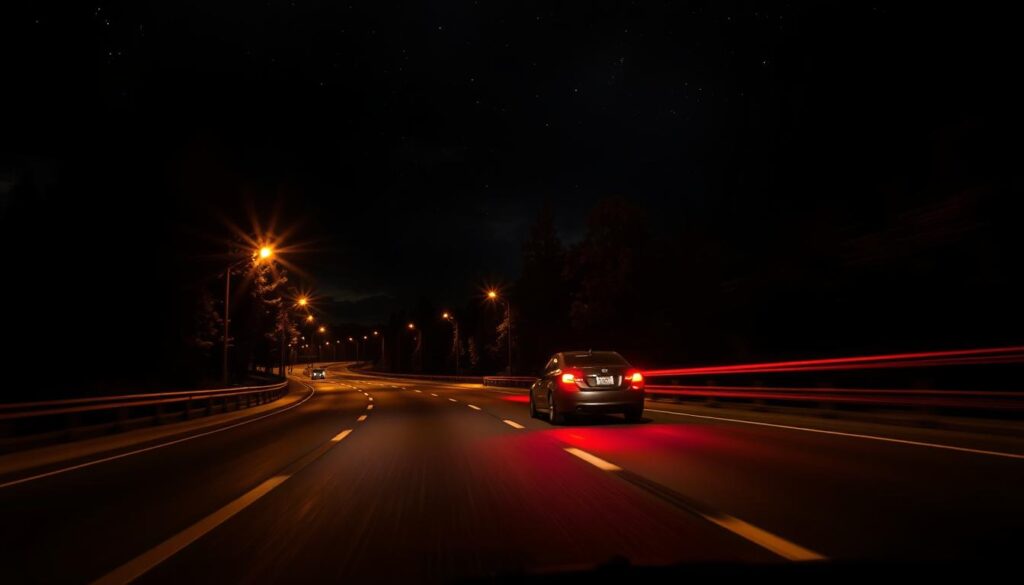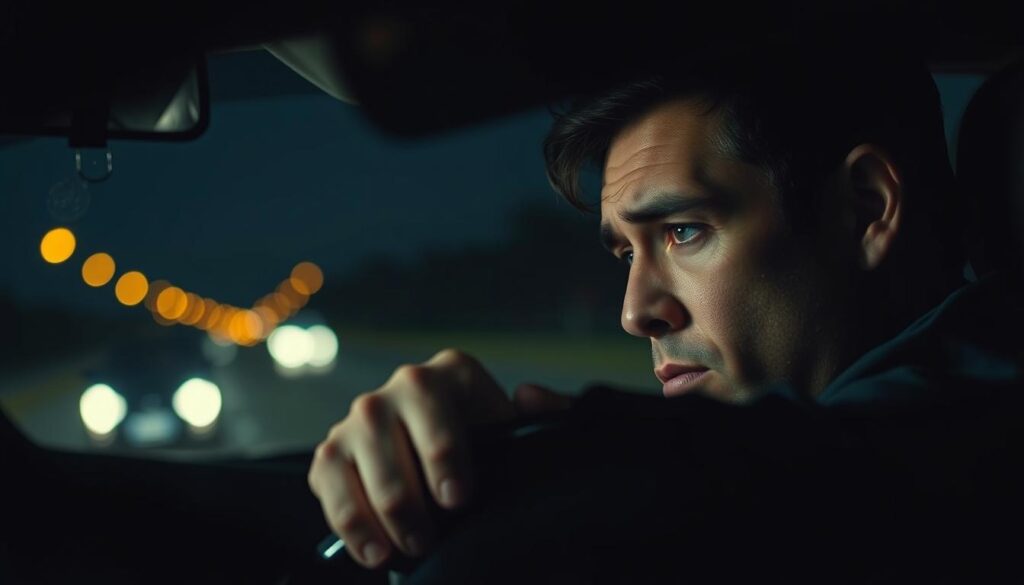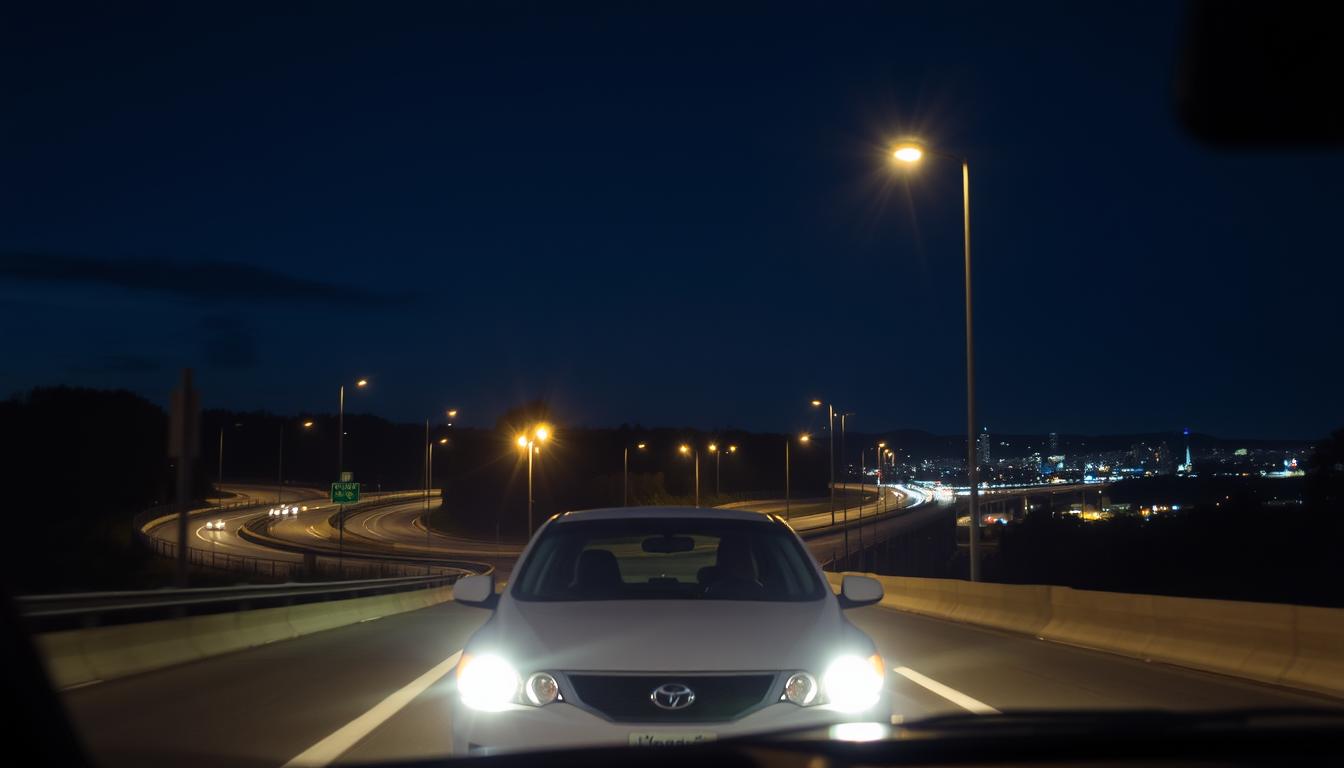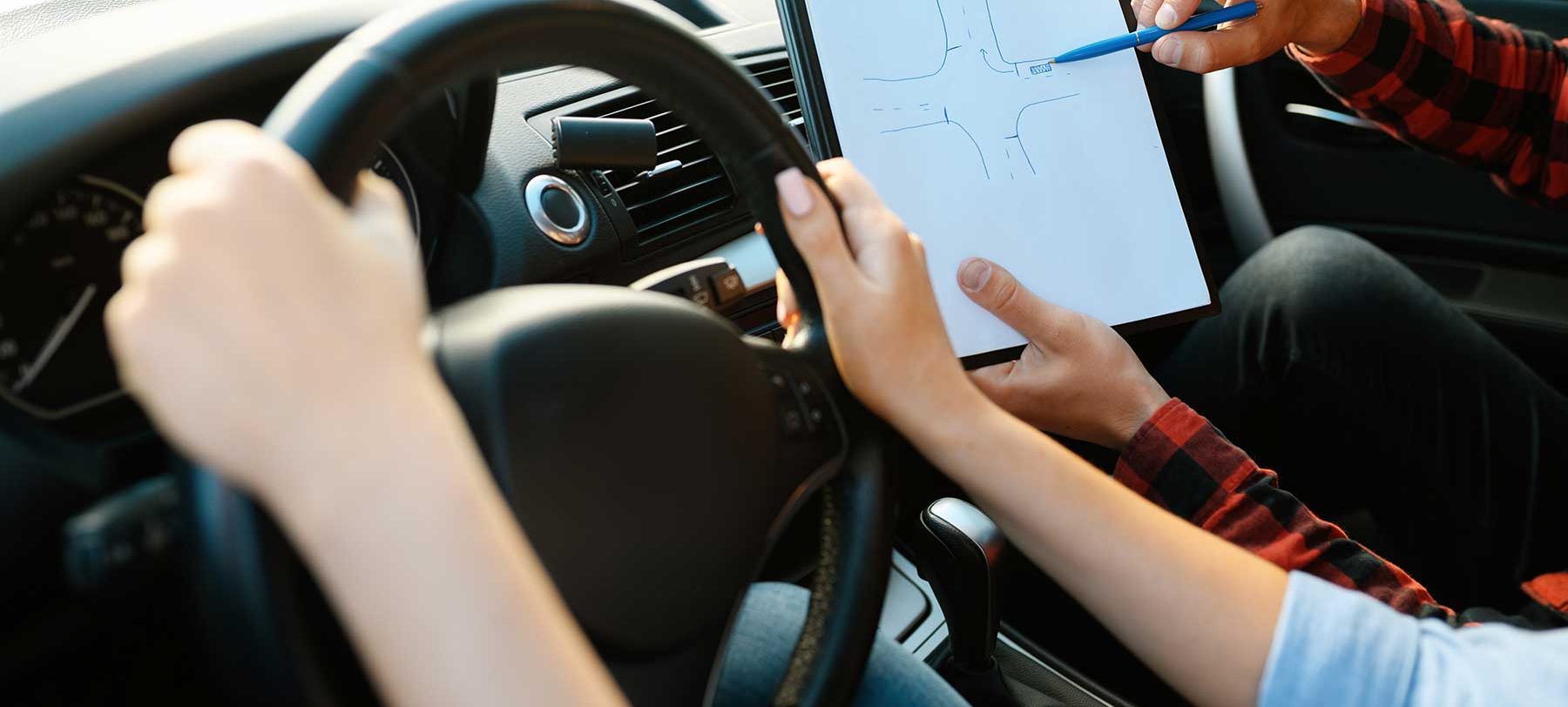Driving at night in New Jersey has its own set of dangers. Whether it’s busy highways or quiet rural roads, staying safe is key. This guide offers vital tips for safe driving in the evening.
At night, it’s harder to spot potholes, animals, and sudden weather changes. Nighttime driving safety in NJ is more than just seeing far. It’s about knowing how to handle every situation. These 7 tips cover important areas like headlights, speed, and staying alert.
Key Takeaways
- 7 tips address NJ-specific hazards like glare, wildlife, and winter roads.
- Headlight maintenance ranks as a top priority for safe night driving New Jersey.
- Rural roads pose higher risks without streetlights or clear markings.
- Adapting speed to visibility is critical for accident prevention.
- These strategies align with NJ traffic laws and real-world road conditions.
The Challenges of Driving After Dark in New Jersey
Nighttime brings special risks for drivers in New Jersey. As it gets dark, NJ nighttime driving hazards grow. This makes both highways and local streets dangerous. The lack of New Jersey dark road visibility and evening driving dangers test your awareness and readiness.
Limited Visibility on NJ Highways and Local Roads
Highways like the NJ Turnpike are hard to navigate at night. Shadows make it tough for headlights to work well. Rural roads often lack light, hiding potholes and debris until it’s too late.
Even well-known roads like Route 1 and Route 206 become risky when dark road visibility is low.
Higher Accident Rates During Evening Hours
Data shows NJ sees a 25% rise in collisions from 6 PM to midnight. This increase is due to evening driving dangers like sudden stops and hidden intersections. Commuters on the Garden State Parkway face even more risks during rush hour darkness.
Unique Road Hazards in the Garden State After Sunset
- Wildlife: Deer crossings peak at night, especially near wooded areas
- Construction zones: Unmarked lane shifts appear suddenly on dark roads
- Interchange confusion: Merging lanes on the NJTP become harder to navigate
These factors make everyday trips risky. Knowing these challenges is key to staying safe. The next sections will offer safety tips to help you navigate these dangers.
Why Nighttime Driving Safety in NJ Matters
Driving at night in New Jersey is more than just dealing with darkness. It’s about keeping lives and communities safe. The importance of night driving safety is huge, especially when you look at NJ traffic statistics. In 2022, over 40% of traffic deaths in the state happened between 6 PM and 6 AM. This is despite fewer cars on the road during those hours.
These numbers are not just statistics. They are real stories. Imagine hitting the brakes hard to avoid a deer or struggling to see a stopped car ahead. Every year, thousands of crashes could be prevent night accidents with better preparation. Here’s what’s at stake:
- Higher insurance premiums after collisions
- Lifelong emotional trauma for victims and families
- Risk to NJ’s densely populated roads, where even small mistakes escalate quickly
“Night driving demands double the caution. Our roads are designed for daylight, but drivers must adapt,” says the New Jersey Department of Transportation.
Preventing accidents isn’t just about following rules. It’s about keeping families safe. Simple steps like cleaning headlights or adjusting speed for low visibility can greatly reduce risks. When you prioritize safety, you protect yourself and the 9 million residents who share NJ’s busy highways every night.
Think of it this way: every choice you make at night has an impact beyond your car. By understanding the importance of night driving safety, you’re part of a community effort to make New Jersey’s roads safer for everyone.
Proper Headlight Usage for Night Visibility
Driving at night in New Jersey needs the right headlight use. This ensures better visibility and lowers road risks. Clean, well-kept headlights can increase your visible distance by a lot during evening drives.
“Using headlights correctly isn’t optional—it’s a legal requirement for safe travel.” — New Jersey Department of Transportation
When to Use High Beams vs. Low Beams
Knowing when to use high beams vs. low beams is key. Use high beams on empty rural roads with no cars ahead. Switch to low beams when you see oncoming cars or are following another vehicle. Low beams are a must in fog or heavy rain to avoid glare.
Maintaining Clean and Properly Aimed Headlights
Dirty headlights can cut brightness by up to 50%. Clean them weekly with a soft cloth and glass cleaner. Also, check their aim yearly—misaligned beams can blind others or leave blind spots. NJ laws require both lights to work and aim right.
New Jersey Laws Regarding Headlight Use
- Headlights must be on 30 minutes after sunset to 30 minutes before sunrise.
- Driving without headlights in low-visibility conditions can cost $50+.
- Driving with one burnt-out bulb is illegal and dangerous.
The Dangers of Driving with One Headlight
Driving with just one headlight cuts contrast and depth perception. NJ laws penalize this risk. Fix burnt bulbs right away to stay safe and legal.
Maintaining Safe Speeds and Following Distances

At night, you need to slow down, even if you’re not speeding. Night driving speed safety means driving 5–10 mph slower on winding roads or where deer cross often. This is because it takes longer to stop in the dark.
The 4-second rule is key for safe following distance. Look ahead and count “one thousand one” as the car in front passes a point. Then, count three more seconds. If you reach the point before four seconds, you need to increase your gap. This helps with glare and unexpected dangers in New Jersey’s rural areas.
- Use your speedometer—don’t rely on feeling to judge speed
- Cut speed by 15% in light rain or fog
- Check speed limit signs on highways like the NJ Turnpike where limits drop after dark
| Condition | Following Distance |
|---|---|
| Daytime | 3 seconds |
| Night | 4 seconds |
| Rain/fog | 5+ seconds |
State data shows 40% of NJ’s nighttime accidents are due to speeding. Slow down near sharp curves on roads like Route 9W where deer are active. Even if limits are 55 mph, driving 45 mph is safer in dark areas. Make these adjustments to stay safe in low light and unpredictable conditions.
Dealing with Glare from Oncoming Traffic
Driving at night in New Jersey can be tough, especially on winding roads. Learning how to reduce headlight glare and manage bright lights driving is crucial. These night driving glare tips help keep you safe and follow state road safety rules.
Techniques to Reduce Headlight Gllace Impact
- Align your gaze to the right side of the road, using the white edge line as a visual guide.
- Adjust your rearview mirror to the night mode to block reflections.
- Wear anti-glare glasses or clean your windshield to minimize light scatter.
These steps help maintain control during moments of sudden glare.
Recovery Time After Exposure to Bright Lights
Even a brief glare flash can leave eyes vulnerable. Studies show vision may take up to 10 seconds to recover, doubling stopping distances. Slow down and stay in your lane until full vision returns.
Special Considerations for Older Drivers
Aging eyes need 2–3 times longer to adjust. Schedule regular vision checks and avoid long nighttime drives during peak glare hours. Pair with a passenger or plan routes with minimal two-lane roads to stay safe.
Staying Alert and Combating Driver Fatigue
Night driving in New Jersey needs your full attention. Plan ahead to fight driver fatigue. After midnight, it’s harder to stay awake, especially on long roads like I-80 or the New Jersey Turnpike. A short nap before you start can help keep you alert at night.
- Rest: Aim for 7-8 hours of sleep before any nighttime trip.
- Caffeine: A small coffee can temporarily boost alertness but isn’t a long-term solution.
- Breaks: Stop every 2 hours at NJ Turnpike service areas or rest stops to reset focus.
- Signs of Risk: Watch for frequent blinking, drifting lanes, or daydreaming—these are red flags.
| Tip | Action |
|---|---|
| 1. Pre-trip prep | Ensure 7-8 hours of sleep |
| 2. Break schedule | Stop every 2 hours at designated areas |
| 3. Nutrition | Avoid heavy meals that cause drowsiness |
| 4. Partners | Share driving with a companion on long trips |
| 5. Caffeine strategy | Limit to 100-200 mg (1 cup coffee) for short-term alertness |
| 6. NJ resources | Use state DOT’s drowsy driving prevention NJ resources |
| 7. Legal awareness | Know NJ’s traffic laws penalizing reckless drowsy driving |
| 8. Emergency plans | Keep a checklist in the car for fatigue prevention steps |
“Drowsy driving slows reaction times similarly to drunk driving at 0.08 BAC.” – NJ Department of Transportation

New Jersey law requires drivers to pull over if they’re too tired. Service plazas along I-95 and the Garden State Parkway offer safe places to rest. Fighting drowsy driving in NJ starts with knowing that staying alert is crucial for safety.
Navigating NJ’s Poorly Lit Rural Roads
Driving at night in New Jersey’s rural areas can be scary. Places like Sussex, Warren, or Hunterdon counties have few streetlights. Here are some tips to stay safe while driving in these areas.
Identify No-Lit Zones Before You Go
- Use NJDOT’s official maps to spot stretches of road without lighting.
- Download offline GPS apps like Waze or Google Maps for real-time guidance.
- Check road condition reports from NJ’s DriveNJ website before departure.
Landmark Navigation Tips
When driving without streetlights, look for landmarks:
- Watch for mile markers and road signs even in low light.
- Use distant landmarks like church spires or water towers as waypoints.
- Turn on your headlights’ low beams to highlight edges of the road.
Stay Safe If You Get Lost
What to do if you get lost:
- Pull over to a wide, paved shoulder. Turn on hazard lights but keep doors locked.
- Use a flashlight (not phone light) to check maps, avoiding screen glare.
- Contact local authorities via 911 if unsure of location.
| Dark Road Safety Tips | Action Steps |
|---|---|
| Check vehicle lights | Test headlights, taillights, and brake lights before trips |
| Reduce speed | Lower speed by 10-15 mph in unlit zones |
| Share your route | Inform someone of your planned path and expected arrival |
Pro tip: Reflective road markers can guide you. They’re often in NJ rural road navigation areas. Stay alert but calm—most rural roads are safer than they seem with proper prep!
Handling Wildlife Encounters on Garden State Roads
New Jersey’s roads are risky due to its dense deer population. Deer collision prevention NJ begins with knowing the risks. Every year, over 20,000 deer hit cars, especially in autumn.
Be careful at night in areas where wildlife is common. Deer travel in groups, so seeing one means more are coming. Slow down near woods and follow animal crossing safety signs. Drive at 45 mph or less in risky areas after dark.
- Look for reflective eyes along roadsides, especially between 6 PM and midnight.
- Use high beams when safe to see ahead, but switch to low beams if deer appear.
- Brake firmly if a deer crosses but avoid sudden swerves—keep control to prevent rollovers.
“Deer react unpredictably. Stay calm and prioritize steering stability over acceleration.” – NJ Division of Fish and Wildlife
In northwestern counties, watch for bears and bobcats near state forests. Raccoons and foxes are common in suburbs. If you hit a deer, move to a safe spot, call the police, and note the location for insurance. Many NJ insurers lower rates for deer-whistle devices—check with yours.
Always be alert, but be extra careful from October to December. Knowing how to handle animal crossing safety can save lives and lower repair costs.
Weather Considerations for Night Driving in New Jersey
Driving at night in New Jersey gets harder when the weather is bad. You need to watch out for fog, winter storms, and coastal winds. Learning how to handle these can save lives.
Fog and Rain Visibility Techniques
Fog makes it hard to see fast. Use low beams and slow down. Also, use GPS for routes and avoid sudden stops. Places like the Meadowlands need extra care.
- Keep windows closed to prevent mist buildup.
- Use windshield wipers to clear heavy rain instantly.
Winter Night Driving Precautions
Winter night safety is all about being ready. Black ice forms quickly on bridges and overpasses. Always check NJDOT alerts before you go. Here are some tips:
- Carry sand or cat litter for traction if stuck.
- Keep an emergency kit with blankets and a flashlight.
Shore Area Wind and Sand Hazards
Coastal roads face strong winds and sand clouds. The Atlantic City Expressway and Garden State Parkway near the shore need extra attention. Watch for sudden gusts and sand-blown debris.
- Use defrosters to clear windows faster.
- Follow larger vehicles to see road edges but stay 3+ car lengths back.
Essential Emergency Supplies for Night Journeys
Having a night driving emergency kit is crucial for safety during unexpected stops. In New Jersey’s diverse road conditions, the right car safety supplies NJ are essential. They prepare you for any situation.
- Reflective vests and triangles: These help drivers see you on dark highways like the Garden State Parkway.
- Flashlights with extra batteries: Ideal for checking flat tires or navigating poorly lit areas.
- First-aid kit and emergency blanket: Essential for minor injuries or warmth during winter breakdowns.
- Portable phone charger: Keeps you connected to call services like NJ Turnpike Authority’s 1-800-772-5623.
“Roadside emergency preparedness starts with visibility. Reflective gear makes all the difference after sunset,” says NJ AAA’s safety team.
Remember to include NJ-specific items like sandpaper or chains for winter trips. Keep a list of local tow companies and NJDOT’s emergency hotline in your phone. Check your supplies regularly to keep them up-to-date. A well-organized night driving emergency kit can turn emergencies into manageable moments, not disasters.
Conclusion
This summary shows how to stay safe driving at night in New Jersey. It covers keeping headlights bright, driving at the right speed, and handling glare from other cars. These tips help lower risks on all types of roads.
It’s important to know about New Jersey’s special dangers, like animals crossing the road or fog near the shore. Being aware helps you stay safe.
Even small actions can make a big difference. Clean your headlights and slow down in dark areas. If glare is a problem, slow down and stay calm. These steps help you handle dangers better.
Safe driving is not just about avoiding accidents. It’s about feeling confident while driving.
Begin with one tip, like checking tire pressure or using fog lights in the rain. Over time, these habits become easy. Everyone should be ready for the roads in New Jersey.
Every time you adjust your speed or follow a road sign, you help keep everyone safe. These steps make driving home or exploring the Garden State at night safer.
Safe driving is more than following rules. It’s about protecting yourself and others. With these tips, every night drive can be safe and worry-free. Drive smart, stay alert, and enjoy New Jersey day or night.







